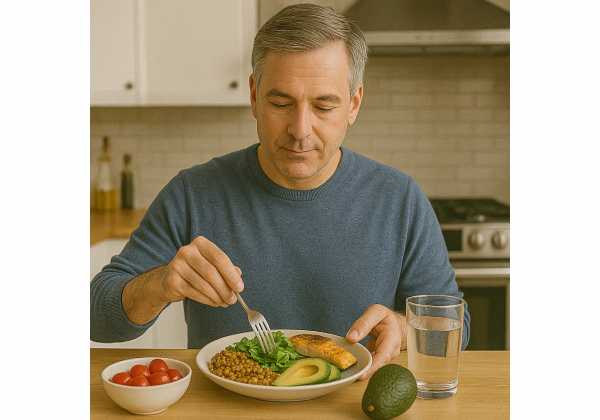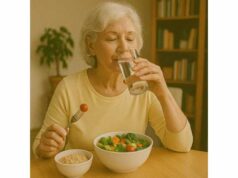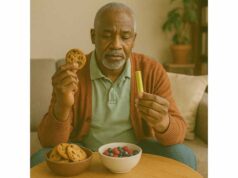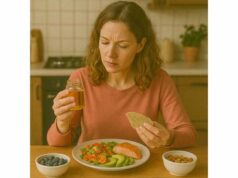
A longer, healthier life is tightly linked to the quality of your blood lipids—especially apolipoprotein B (ApoB), LDL (“bad”) cholesterol, HDL (“good”) cholesterol, and triglycerides. While genes and age play a role, day-to-day nutrition can shift these numbers in meaningful, measurable ways. This guide translates the best evidence into practical plate moves you can start using this week. We’ll clarify which markers matter most, why ApoB has become a priority, and how to lower risk with clear food strategies, smart carbohydrate choices, and targeted omega-3s. If you want an even broader foundation, consider the principles in nutrition for longevity—then use this article to focus tightly on lipids.
Table of Contents
- Understanding LDL, HDL, Triglycerides, and ApoB
- Dietary Patterns That Lower ApoB and Improve Risk
- Fiber, Plant Sterols, and Nuts: What Works Best
- Omega 3s for Triglycerides and Vascular Health
- Carbs, Saturated Fat, and Cholesterol: Prioritization Guide
- Sample Day and Weekly Targets for Lipid Health
- Lab Testing Cadence and Non Diet Levers
Understanding LDL, HDL, Triglycerides, and ApoB
When you and your clinician talk about “cholesterol,” you’re usually referring to the cholesterol carried inside lipoprotein particles. The key players:
- LDL cholesterol (LDL-C): the cholesterol content inside low-density lipoprotein particles that deliver cholesterol to tissues. Higher LDL-C generally means more atherosclerotic risk over time.
- HDL cholesterol (HDL-C): the cholesterol carried by high-density lipoprotein particles involved in reverse transport. Higher HDL-C often tracks with healthier habits but is not a treatment target by itself.
- Triglycerides (TG): fat molecules transported mainly in VLDL particles after meals and from liver synthesis. Persistently high TG often signals insulin resistance or excess refined carbohydrate intake.
- Apolipoprotein B (ApoB): the structural protein on every atherogenic particle—VLDL, IDL, LDL, and lipoprotein(a). Each particle carries one ApoB, so ApoB closely reflects the number of artery-penetrating particles, not just their cholesterol cargo.
Why this distinction matters: LDL-C is the amount of cholesterol inside LDL particles; ApoB counts the particles themselves. Two people can have the same LDL-C but different ApoB because one carries cholesterol in fewer, larger particles while the other carries it in more, smaller ones. The second situation (higher ApoB) means more particles contacting the artery wall per unit time—more opportunities for retention and plaque formation.
Practical interpretation:
- ApoB: a strong, particle-based measure of risk. Many clinicians now use ApoB alongside—or instead of—non-HDL-C to gauge residual risk, especially when triglycerides are elevated or when LDL-C and non-HDL-C disagree with clinical risk.
- Non-HDL-C: (total cholesterol − HDL-C) approximates all atherogenic cholesterol and is a good stand-in when ApoB isn’t available.
- Triglycerides: consistently >150 mg/dL raise concern; >200 mg/dL suggests insulin resistance or secondary causes (alcohol, certain meds, hypothyroidism) and merits targeted nutrition.
- HDL-C: useful as context (very low levels often travel with high triglycerides), but raising HDL-C per se is not a treatment goal.
Signals to discuss with your clinician:
- ApoB above optimal for your risk category (for many primary prevention adults, a practical goal is often <80–90 mg/dL; for higher-risk patients, lower targets are typical).
- Triglycerides persistently above 150–175 mg/dL despite lifestyle efforts.
- Lipoprotein(a) once-in-a-lifetime screening, since elevated Lp(a) adds risk regardless of LDL-C.
Bottom line: use LDL-C, non-HDL-C, and ApoB together to see both cholesterol and particle number. That lens shows you which diet moves will matter most for you.
Dietary Patterns That Lower ApoB and Improve Risk
Instead of chasing single “superfoods,” anchor your plate to a pattern that consistently lowers ApoB and LDL-C while improving triglycerides and overall cardiovascular risk. Several approaches stand out:
1) Mediterranean-style eating.
Emphasize vegetables, fruits, legumes, whole grains, nuts, seeds, and olive oil; include fish 2–4 times weekly; keep red and processed meats, refined grains, and sweets as occasional items. Mechanisms include replacing saturated fat with monounsaturated and polyunsaturated fats, increasing fiber and polyphenols, and lowering glycemic load. Expect modest LDL-C reductions, better triglycerides (especially when coupled with weight loss), and improvements in blood pressure and inflammation. If you’re starting from scratch, a practical primer is our Mediterranean starter guide.
2) Portfolio diet.
This pattern “bundles” four cholesterol-lowering food groups shown to add up:
- Viscous fiber (oats, barley, psyllium, okra, eggplant, beans)
- Plant sterols/stanols (enriched yogurts/spreads, fortified soy/almond drinks)
- Nuts, especially almonds and walnuts
- Soy proteins (tofu, tempeh, edamame, soy milk)
In controlled trials, the combined effect produced LDL-C reductions comparable to a low-dose statin. The Portfolio pattern is also entirely compatible with a Mediterranean base; many people successfully run a “Med-Portfolio” hybrid.
3) DASH-like or plant-forward patterns.
DASH emphasizes fruits, vegetables, low-fat dairy, legumes, and whole grains while limiting sodium and red meat. It reliably lowers blood pressure and usually moves LDL-C down modestly. A fully plant-based approach can be highly effective when it’s built around whole foods (legumes, whole grains, nuts/seeds, vegetables, fruits) rather than refined starches.
4) Low-carbohydrate done well.
Low-carb strategies can improve triglycerides and glycemic control, but outcomes hinge on fat quality. Low-carb with high unsaturated fat (olive oil, nuts, seeds, fish, avocado) tends to lower ApoB/LDL-C more than low-carb with high saturated fat (butter, coconut oil, fatty cuts of meat). If you choose low-carb, keep saturated fat conservative and emphasize fiber-rich plants.
5) Weight reduction when indicated.
A 5–10% body weight loss often lowers triglycerides by 15–30%, raises HDL-C slightly, and can nudge ApoB down via fewer VLDL particles produced by the liver. Focus on a sustainable energy deficit paired with resistance training to preserve muscle.
Expected magnitudes (individual results vary):
- Med-style: LDL-C ↓ ~5–10%, TG ↓ ~5–15% (larger with weight loss).
- Portfolio components combined: LDL-C ↓ ~20–30%.
- Plant-forward DASH: LDL-C ↓ ~5–10%.
- Low-carb unsaturated-fat emphasis: TG ↓ ~15–30%; LDL-C effects depend on saturated fat restraint.
Choose the pattern you can maintain—and layer Portfolio elements into whichever base you select.
Fiber, Plant Sterols, and Nuts: What Works Best
If you want the biggest “food-as-therapy” effect on ApoB/LDL-C without medication, target three levers: viscous fiber, plant sterols/stanols, and nuts. They work through complementary mechanisms and stack well.
Viscous (soluble) fiber
- How it works: forms gels in the gut that trap bile acids; the liver pulls cholesterol from circulation to make more bile, lowering LDL-C and ApoB over time.
- Daily target: 5–10 g/day of viscous fiber within 25–38 g/day total fiber.
- Top sources: oats/oat bran, barley (β-glucan), psyllium husk, beans/lentils, okra, eggplant, ground flaxseed, chia.
- Practical moves: 2–3 Tbsp psyllium (split doses with water), 1 cup cooked oats or barley, a daily legume serving, and a tablespoon of ground flax or chia.
Plant sterols/stanols (phytosterols)
- How they work: compete with cholesterol for absorption in the small intestine, reducing the cholesterol reaching the liver.
- Daily target: ~2 g/day from fortified foods/supplements.
- Expected effect: LDL-C ↓ ~7–10% on average; works additively with statins and with dietary changes.
- Sources: fortified spreads/yogurts, enriched soy/almond beverages, specific “heart-healthy” products that list sterol/stanol content per serving.
- Usage tips: split into two or three meals; pair with a diet already lower in saturated fat for the best total effect.
Nuts (tree nuts and peanuts)
- How they work: replace saturated fat with unsaturated fat, add fiber, minerals (magnesium, potassium), and phytochemicals; modest LDL-C and ApoB reductions with neutral to favorable effects on HDL-C.
- Daily target: 30–60 g/day (a small handful is ~28–30 g).
- Best studied: almonds, walnuts, pistachios; but mixed nuts also perform well.
- Practical swaps: nuts instead of crisps/crackers; nut + fruit as a snack; walnut or almond “sprinkle” on salads and grain bowls.
- Caution: mind portions for energy balance; choose unsalted or lightly salted varieties if you’re managing blood pressure.
Stacking guide (example day):
- Breakfast: 1 cup oatmeal + 1 Tbsp ground flax (viscous fiber)
- Lunch: bean-and-barley soup (viscous fiber) + side salad with 30 g almonds (nuts)
- Dinner: vegetables and tofu with barley or quinoa; use a sterol-enriched yogurt as dessert (phytosterols)
These three levers integrate smoothly into Mediterranean, DASH, or plant-forward eating. For deeper fiber planning and food lists, see fiber targets and sources.
Omega 3s for Triglycerides and Vascular Health
Omega-3 polyunsaturated fatty acids—especially EPA (eicosapentaenoic acid) and DHA (docosahexaenoic acid)—improve triglyceride metabolism and support vascular function.
What to expect for triglycerides
- Food-first approach: Eating fatty fish 2–4 times per week (e.g., salmon, sardines, herring, mackerel, trout) often reduces triglycerides modestly and improves the overall lipid profile by displacing refined carbohydrates and high-saturated-fat foods.
- Therapeutic doses: 2–4 g/day of EPA+DHA (prescription strength) can lower triglycerides by ~20–30%, with greater effects at higher baseline TG. Prescription products ensure purity, dose, and regulatory oversight.
EPA versus EPA+DHA
Outcomes trials support high-dose purified EPA in select patients with persistent hypertriglyceridemia on statins. Combined EPA+DHA lowers triglycerides reliably; effects on LDL-C vary (small increases can occur with some DHA-containing products), but ApoB typically declines when triglycerides fall and overall particle burden improves.
Safety and timing
- Take with meals to reduce reflux/fishy aftertaste.
- Discuss with your clinician if you have bleeding disorders, are on anticoagulants, or have atrial fibrillation history.
- Do not conflate over-the-counter fish oil of uncertain dose with prescription ethyl-EPA or EPA+DHA; labels frequently underdose EPA/DHA per capsule.
Food sources to prioritize
- Best: salmon, sardines, Atlantic mackerel, herring, trout, anchovies.
- Plant-based option: algae-derived DHA/EPA for those avoiding fish. ALA (from flax, chia, walnuts) is welcome but converts inefficiently to EPA/DHA.
Putting it in the week
- Two fish dinners plus one lunch featuring sardines or trout will usually meet general omega-3 goals. If triglycerides are persistently >200 mg/dL, talk with your clinician about a prescription omega-3 strategy layered onto diet and exercise. For practical shopping and recipe ideas, explore omega-3 food choices.
Carbs, Saturated Fat, and Cholesterol: Prioritization Guide
Diet choices shift lipids through a few dominant pathways. Use this prioritization framework to focus on the changes that matter most for ApoB, LDL-C, and triglycerides.
1) Replace saturated fat with unsaturated fat
- Why: Saturated fat (SFA) raises LDL-C via down-regulation of LDL receptors, keeping ApoB-containing particles in circulation longer.
- How: Swap butter/cream/coconut oil/fatty cuts of beef or lamb for olive oil, avocado, nuts, seeds, and fish. Choose low-fat or fermented dairy more often than full-fat if LDL-C or ApoB are above goal.
- Expected effect: LDL-C reduction when ~5–10% of total calories from SFA shift to MUFA/PUFA.
2) Tame refined carbohydrates to lower triglycerides
- Why: High glycemic load drives hepatic VLDL production, pushing triglycerides up and HDL-C down.
- How: Emphasize intact grains (steel-cut oats, barley, farro), legumes, and fiber-rich fruits; limit sugary beverages, juices, sweets, and refined flour snacks.
- Meal timing: Larger carbohydrate loads earlier in the day or around activity often produce better post-meal profiles than late-night, sedentary eating.
3) Keep dietary cholesterol in context
- For most people, dietary cholesterol has modest effects on LDL-C compared with saturated fat. Eggs can fit in a lipid-conscious pattern, particularly when the overall plate is rich in vegetables and unsaturated fats. If you are a “hyper-responder” or have familial hypercholesterolemia, your clinician may advise tighter limits.
4) Use viscous fiber and phytosterols surgically
- Add psyllium (2–3 tsp twice daily) or β-glucan from oats/barley and ~2 g/day plant sterols/stanols to amplify LDL-C reductions you achieved by fat quality shifts.
5) Alcohol and triglycerides
- Alcohol raises triglycerides in a dose-dependent fashion and can exacerbate fatty liver. If TG are high, trial 2–4 alcohol-free weeks and re-check numbers.
6) Protein distribution and substitution
- Replace some refined carbs with plant protein (soy, beans, lentils) and fish. Higher-quality protein choices improve satiety and support weight management that indirectly lowers ApoB.
Practical order of operations
- Cut SFA to a reasonable baseline; swap in olive oil, nuts, seeds, and fish.
- Remove refined sugars and ultra-processed snacks; bring in legumes and intact grains.
- Add viscous fiber and consider phytosterols.
- Right-size alcohol.
- Evaluate progress and personalize from there.
For a broader roadmap to building satisfying plates around these principles, see our guide to healthy fats in longevity eating.
Sample Day and Weekly Targets for Lipid Health
A plan that works in real kitchens will beat any theoretical “perfect” diet. Use this sample day as a template, then hit the weekly targets that move ApoB, LDL-C, and triglycerides.
Daily targets
- Total fiber: 30–40 g (with 5–10 g viscous).
- Unsaturated fats: most added fat from extra-virgin olive oil; include nuts/seeds daily.
- Saturated fat: generally ≤10% of calories (lower if ApoB/LDL-C are above goal).
- Phytosterols: ~2 g/day from fortified foods, if LDL-C reduction is a priority.
- Added sugars: keep low; aim for ≤25–36 g/day depending on energy needs.
- Protein: distribute across meals (e.g., 25–35 g per meal) to maintain muscle.
Sample day (mix-and-match)
- Breakfast: Steel-cut oats cooked with soy milk; top with blueberries, 1 Tbsp ground flaxseed, and chopped walnuts. Coffee or tea.
- Snack: Apple + 30 g almonds.
- Lunch: Lentil-barley soup; big salad with olive-oil vinaigrette and canned sardines or grilled tofu; whole-grain roll (optional).
- Snack (optional): Plain yogurt (or fortified plant yogurt) with chia and a drizzle of honey.
- Dinner: Roasted salmon (or marinated tempeh) with a tray of vegetables, garlic-herb olive oil, and a side of quinoa or farro.
- Evening: If using phytosterols, include a sterol-enriched yogurt/spread with a small whole-grain cracker portion.
Weekly targets
- Fish: 2–4 meals featuring salmon, sardines, trout, mackerel, or herring.
- Legumes: 7+ servings (e.g., ½ cup cooked beans/lentils per serving).
- Whole grains: Oats and barley several times weekly for β-glucan; rotate with quinoa, farro, brown rice.
- Nuts/seeds: 5–7 days per week, 30–60 g/day.
- Vegetables and fruits: At least 5 servings daily; include leafy greens and colorful options.
- Olive oil: Use as the default cooking and dressing fat.
Budget and convenience tips
- Canned fish (sardines, salmon) and frozen vegetables keep costs down.
- Batch cook beans and whole grains; freeze in single-meal containers.
- Psyllium is inexpensive and potent—add to breakfast and dinner.
- Fortified sterol products: compare labels for sterol content per serving to hit ~2 g/day.
Prefer a single framework to simplify meal planning? Our plate method in protein-plus-produce meals helps you assemble lipid-friendly dishes fast.
Lab Testing Cadence and Non Diet Levers
What to measure
- ApoB (or non-HDL-C when ApoB isn’t available) as the central atherogenic particle measure.
- Fasting lipid panel: LDL-C, HDL-C, triglycerides (nonfasting is fine for routine care; fasting helps when triglycerides run high).
- Glucose/insulin resistance context: A1C or fasting glucose if weight, triglycerides, or blood pressure change.
- Lipoprotein(a) once in a lifetime, earlier if family history of premature cardiovascular disease.
- Optional: hs-CRP, thyroid-stimulating hormone if triglycerides are unexpectedly high.
When to test
- Baseline, then 6–12 weeks after making substantial diet or medication changes to see the true direction of travel.
- If stable, every 6–12 months is reasonable; tighter intervals if higher risk or actively titrating therapy.
- After a weight-loss phase, re-check once your weight has settled for at least 4–6 weeks.
Non-diet levers with strong evidence
- Physical activity: Aim for 150–300 minutes/week of moderate aerobic work (or 75–150 minutes vigorous), plus 2–3 resistance sessions. Exercise improves triglyceride handling (more LPL activity), raises HDL-C, lowers blood pressure, and supports weight maintenance.
- Weight management: A 5–10% reduction meaningfully lowers triglycerides and often improves ApoB; preserve lean mass with adequate protein and resistance training.
- Sleep and stress: Short sleep and high stress increase appetite for refined carbohydrates and may worsen TG. Target 7–9 hours and consistent bed/wake times.
- Alcohol: If triglycerides are elevated, trial 2–4 weeks without alcohol and retest.
- Medications when indicated: If ApoB/LDL-C remain above target after lifestyle changes—or if your baseline risk is high—discuss proven therapies: statins (first-line), ezetimibe, bempedoic acid, PCSK9 inhibitors, and in select patients with persistent hypertriglyceridemia, prescription omega-3s (e.g., purified EPA). These can be layered onto diet to reach particle goals safely.
How to use results to adjust your plan
- High ApoB with normal triglycerides: double down on saturated-fat substitution, viscous fiber, and sterols; consider medication if risk is high.
- High triglycerides with low HDL-C: prioritize refined carbohydrate reduction, fish/omega-3s, alcohol limits, weight loss, and activity timing (walks after meals).
- ApoB and LDL-C discordant: trust ApoB as the better estimate of particle burden; adjust intensity of diet/therapy accordingly.
Your numbers are dynamic markers of artery exposure—treat them as feedback, not fixed traits.
References
- APOLIPOPROTEIN B: Bridging the gap between evidence and practice 2024 (Review)
- Plant Sterols and Plant Stanols in Cholesterol Management and Cardiovascular Health 2023 (Systematic Review)
- Effects of Nut Consumption on Blood Lipids and Lipoproteins: A Systematic Review and Meta-Analysis of Randomized Controlled Trials 2023 (Systematic Review and Meta-analysis)
- Omega-3 Fatty Acids for the Management of Hypertriglyceridemia 2019 (Scientific Statement/Guidance)
- 2019 ESC/EAS Guidelines for the management of dyslipidaemias: lipid modification to reduce cardiovascular risk 2019 (Guideline)
Disclaimer
This article provides general nutrition and health information and is not a substitute for personalized medical advice, diagnosis, or treatment. Always consult your clinician or a qualified dietitian about your specific risk factors, lab results, medications, and dietary needs—especially if you have cardiovascular disease, diabetes, kidney or liver conditions, or are considering supplements or prescription omega-3s.
If you found this guide useful, please consider sharing it on Facebook, X, or your preferred platform, and follow us for future updates. Your support helps us continue creating careful, evidence-based content.










